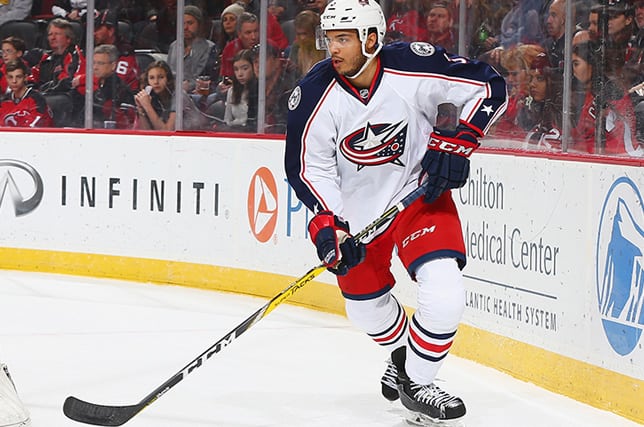
Seth Jones' six-year, $32.4-million deal creates pickle for Blue Jackets – and Jets
Seth Jones' multi-year extension as an RFA forces the Columbus Blue Jackets – and Winnipeg Jets? – to make difficult decisions.
 Seth Jones' six-year, $32.4-million deal creates pickle for Blue Jackets – and Jets
Seth Jones' six-year, $32.4-million deal creates pickle for Blue Jackets – and JetsA clear sign we're scaling the peak of NHL off-season activity? A star player signs a contract, and all we want to talk about is the context, the ripple effect, how it plays into other transactions.
The Columbus Blue Jackets announced Wednesday they'd locked up their franchise defenseman, Seth Jones, on a six-year, $32.4-million contract. It carries a $5.4-million cap hit. Jones was a restricted free agent and hasn't yet maxed out the mammoth upside that made the Nashville Predators choose him fourth overall in 2013, but it was no surprise to see him bypass a short-term bridge contract. Columbus dealt its top-line center, Ryan Johansen, for Jones in January. Jones is clearly part of the Jackets' long-term plans. He has tremendous size at 6-foot-4 and 208 pounds. He's a graceful skater and puck mover. He uses his big reach impeccably on defense, and he can wire a mean slapshot, too. There's an excellent chance his $5.4-million cap hit looks like a bargain within a season or two. He and Zach Werenski forge a formidable blueline tandem to build around for years to come.
"He’s a guy who’s come in and solidified what our team is going to be about going forward," said Blue Jackets captain Nick Foligno Friday on a phone call with THN. "He’s a great skater, he moves the puck extremely well, and that’s what we want to see out of our back end.
“For how young he is, it’s pretty incredible the way he can command on the ice. That's the first thing I noticed, his demeanor. His presence on the ice when he’s playing his game is felt. When he brings it, we’re a way better team. It’s exciting to know he’s going to be here for a while, and we’re looking forward to seeing what he can do now as he grows and becomes more mature and takes on bigger responsibilities. It’s been nothing but plusses having Seth on our team.”
Still, while Jones' contract seems sensible enough, it's not quite highway robbery at this stage of his career. He's averaged a relatively insulated 20:32 of ice time over his first three NHL seasons. His deployment and responsibility have obviously ramped up, especially since he became a Blue Jacket, but it's not like he's played every game against opponents' top forwards. The point here is not that Jones is not a stud – I fully expect him to keep blossoming into an elite NHL blueliner – but merely that the Jackets are paying him for expected production as opposed to what he's accomplished so far in his career. It puts into context some other recent RFA defenseman signings. Morgan Rielly, John Klingberg and Sami Vatanen, to name a few, have played bigger minutes and posted better offensive totals than Jones so far but earned smaller AAVs on their extensions. Jones' deal establishes that trio as bargains.
Columbus now sits with $42,857 in cap space for 2016-17. That's about as up-against-it as a team can get. General manager Jarmo Kekalainen desperately needs to ship some salary out as consequence of re-signing Jones. We know left winger Scott Hartnell has waived his no-trade clause and, as the Globe and Mail's James Mirtle reports, the Jackets are willing to retain salary in trades for their veterans. We can thus expect Kekalainen to be quite active in the weeks to come. Plenty of contending teams should kick the tires on a discounted Hartnell.
And how will Jones' contract impact the man of the hour, Winnipeg Jets defenseman Jacob Trouba? He's one of the toughest RFAs to figure out this off-season. He looked like a future star as a rookie but has regressed a bit in his past two seasons, albeit his deployment has been partially to blame. His possession numbers skyrocket when he's away from regular partner Mark Stuart. Trouba's confidence has been called into question. He seemed like a classic candidate for a bridge contract. It's what teams do with their high-ceiling youngsters who haven't quite realized their potential, right? Well, if the absurd rumors are true, the defense-starved Boston Bruins have made things awfully complicated. Some reports suggest they're preparing an offer sheet that would pay Trouba $7 million or more annually. Jones is probably more valuable than Trouba right now, and he just earned a $5.4-million AAV, so it seems insane for a team to pay Trouba so much more. Jets GM Kevin Cheveldayoff might be wise to walk away rather than match a Bruins offer sheet.
And if the offer-sheet talk proves to be nothing more than talk – which is likely, considering only two players have signed them since 2010 – the Jets still need to lock up Trouba. Might Jones' extension force them to pay Trouba more than they planned? Their career profiles are similar in terms of games and offensive numbers. Jones averages 0.35 points per game and Trouba 0.34. Jones has a slightly better analytics profile, while Trouba has played more minutes. The Trouba camp can suddenly use Jones' deal as leverage to get Trouba inked to a long-term pact should they desire to go that way.
The Jones contract, then, just like Filip Forsberg's earlier this week, could significantly impact several other major roster moves around the league.
Matt Larkin is a writer and editor at The Hockey News and a regular contributor to the thn.com Post-To-Post blog. For more great profiles, news and views from the world of hockey, subscribe to The Hockey News magazine. Follow Matt Larkin on Twitter at @THNMattLarkin

